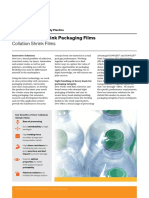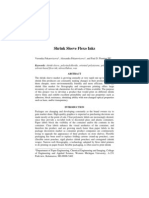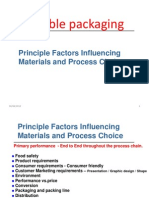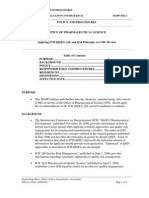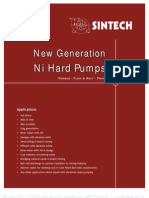100%(1)100% found this document useful (1 vote)
472 viewsMDO Films
MDO Films
Uploaded by
Manoj BansalThis document discusses machine-direction orientation (MDO) of films and the technical challenges involved. It notes that while MDO enhances many film properties and allows for downgauging, developing successful MDO films at commercial scale has proven difficult for most companies. New, more flexible MDO equipment designs may help overcome past challenges by making product development and testing easier. The document provides examples of companies investing heavily in MDO but ultimately abandoning their lines when products could not be successfully commercialized.
Copyright:
© All Rights Reserved
Available Formats
Download as PDF, TXT or read online from Scribd
MDO Films
MDO Films
Uploaded by
Manoj Bansal100%(1)100% found this document useful (1 vote)
472 views5 pagesThis document discusses machine-direction orientation (MDO) of films and the technical challenges involved. It notes that while MDO enhances many film properties and allows for downgauging, developing successful MDO films at commercial scale has proven difficult for most companies. New, more flexible MDO equipment designs may help overcome past challenges by making product development and testing easier. The document provides examples of companies investing heavily in MDO but ultimately abandoning their lines when products could not be successfully commercialized.
Original Description:
Machine Direction Orientation Films
Copyright
© © All Rights Reserved
Available Formats
PDF, TXT or read online from Scribd
Share this document
Did you find this document useful?
Is this content inappropriate?
This document discusses machine-direction orientation (MDO) of films and the technical challenges involved. It notes that while MDO enhances many film properties and allows for downgauging, developing successful MDO films at commercial scale has proven difficult for most companies. New, more flexible MDO equipment designs may help overcome past challenges by making product development and testing easier. The document provides examples of companies investing heavily in MDO but ultimately abandoning their lines when products could not be successfully commercialized.
Copyright:
© All Rights Reserved
Available Formats
Download as PDF, TXT or read online from Scribd
Download as pdf or txt
100%(1)100% found this document useful (1 vote)
472 views5 pagesMDO Films
MDO Films
Uploaded by
Manoj BansalThis document discusses machine-direction orientation (MDO) of films and the technical challenges involved. It notes that while MDO enhances many film properties and allows for downgauging, developing successful MDO films at commercial scale has proven difficult for most companies. New, more flexible MDO equipment designs may help overcome past challenges by making product development and testing easier. The document provides examples of companies investing heavily in MDO but ultimately abandoning their lines when products could not be successfully commercialized.
Copyright:
© All Rights Reserved
Available Formats
Download as PDF, TXT or read online from Scribd
Download as pdf or txt
You are on page 1of 5
tretching film in the machine
direction magnifies its prop-
ertiesnot just a little, but
a lot. MD orientation of
blown and cast films,
whether off-line or in-line
with extrusion, enhances
barrier, stiffness, flatness,
tensile strength, and poros-
ity. It reduces stretchiness
and, of course, makes two or
three times more product
with the same amount of
plastic. Because MDO films
are also very flat, they run many times
faster in downstream converting oper-
ations, adding still more value.
Given all these advantages, why
arent there more MDO film products in
the market? Because most MDO films,
beyond a few relatively simple products
like monolayer stretch film, are very,
February 2005 www.ptonline.com 48
very difficult to get right. For example,
MDO can enhance nylon and EVOH
barrier properties, but it also makes
them brittle. If you know how much to
preheat, how much to stretch, and
where to anneal, you can make a suc-
cessful product, cautions Kevin Hen-
derson, technical marketing manager
at Avery Dennisons Engineered Films
Div., Concord, Ohio.
Machine builders report a growing
volume of processors asking about
MDO equipment, but these processors
often dont have any idea of what they
need or of how difficult a challenge
awaits them. Over the years, at least
three major packaging companies
invested heavily to develop MDO
films and installed multiple production
lines, only to abandon them with little
to show for their effort and expense.
Most MD orienters are used as the
By Jan H. Schut, Senior Editor
S
MDO Films
Lots of Promise,
Big Challenges
Machine-direction orientation is still
discovering new market opportunities. But
the technical difficulties are so great that
some big projects never came of age.
New equipment could make it easier.
www.ptonline.com February 2005 49
on wide lines with high outputs. Mar-
shall & Williams (one of the major
equipment providers) has sold five of its
largest MDO units4 meters wide
for making hygiene films. Davis-Stan-
dard has also built its largest units2
meters widefor hygiene films. SMLin
Austria has built MDO lines for hygiene
films up to 3.2 meters wide.
Processors typically develop new
first stage in biaxial film and sheet pro-
duction. But stand-alone MDO units
have generated innovative film products
since the 1960s, such as PET strapping,
PVC food wrap, foamed PPribbon, and
fibrous HDPE ribbon for weaving sacks.
MDO film hit the big time in the 1990s
with breathable hygienic films for dia-
per liners, self-adhesive labels, and syn-
thetic paper. These products were made
MDO film products on full-scale pro-
duction equipment or on home-made,
half-sized R&D lines. Either way, the
machine design is usually specific to one
product and offers little flexibility.
Although lab-scale MDO lines are avail-
able from M&W and Dr. Collin GmbH
in Germany, they are of limited use to
processors because they are too narrow
to make samples that converters could
Honeywells Aclar fluoropolymer film
gets better moisture barrier from
MD orientation, making it a clear
alternative to aluminum foil.
February 2005 www.ptonline.com 50
and number of cooling rolls.
The number of preheat rollers is
determined not by the amount of stretch
desired, but by the resin and intended
throughput ratemore rollers, more
throughput. Standard preheat-roll
diameters are 12, 18, or 24 in., though
they can get as big as 30 in. Film can
be drawn once or multiple times, punc-
tuated by intermediate heating or
cooling to obtain different effects. Draw-
ing can be done hot or cold.
Drawing is relatively straightfor-
ward. A fast-draw roller turns faster
than a slow-draw roller by a specified
amount, stretching the film in the gap
between them. You just have to find
the right temperature and draw ratio,
and that can be a pain, says Eric Hat-
field, managing director of operations
at FlexTech Packaging Inc. in Cincin-
nati, which specializes in MDO films.
Short-gap stretching is typically
less than 2.5 mm, long-gap stretching
is 5 to 50 mm or more. There is even
so-called zero-gap stretching or
compression-roll drawing. The shorter
the gap, the less film neck-in occurs.
Neck-in typically reduces film width by
5% to 20%. Neck-in also reduces the
breathability that is critical to hygiene
films. SML patented the use of rubber
drawing rolls that reduce neck-in.
Annealing is the hardest part, says
Flex Techs Hatfield, because film can be
made to stretch or shrink by speeding
up or slowing down the annealing rolls.
Any change in speed or temperature
changes the resulting film properties.
MDOs ability to downgauge film
and improve its properties at the same
time is a compelling combination. Down-
gauging is a large part of why proces-
sors try so hard to make MDO work.
Honeywell Specialty Materials took sev-
eral years to develop an MDO version of
its Aclar monolayer PCTFE fluoropoly-
mer film to replace metal foil with a clear
moisture barrier. Honeywell found that
monoaxially stretching Aclar film dou-
bled its moisture barrier, so 25-micron
MDO Aclar has the same moisture bar-
rier as 50-micron unoriented Aclar.
MDO Aclar is close to its first com-
mercial use in a pharmaceutical pack-
age. The film is made in
Pottsville, Pa., on three
high-temperature ori-
enters from Marshall &
Williams with oil-
heated rollers that can
go up to 600 F.
Stretching
blown film
In the past few
years, the pace of new
MDO film develop-
ments has picked up,
especially those based
on blown film. Machine
builders have respon-
ded to that interest with new hardware
designs.
Bruckner Maschinenbau GmbH in
Germany, inventor of some of the earli-
est biaxial stretching technology, has
now taken an interest in MDO. Last
year, Bruckner set up a new group to
design and build monoaxial stretching
lines for barrier and shrink films. Acom-
pany spokesman notes that these films
are gaining more and more signifi-
cance in the market.
Several builders of blown film
test on full-size converting machines.
Some resin companies, however, have
found lab MDO lines useful.
There are also monoaxial films that
are stretched only in the transverse
direction to make products like shrink
labels. But TDO systems can be even
more limited in product flexibility than
MDO units.
In the past year or so, there has
been a small but significant change in
the flexibility of MDO equipment.
Processors have bought full-sized pro-
duction orienters with extra features
intended purely for R&D. These orien-
ters not only control the temperature
and speed of every roller individually,
they offer multiple web paths and mul-
tiple draw options. This uncommon
level of flexibility should make new film
product development easier.
Too many choices?
MDO equipment can have an
almost unlimited number of variables:
the number and temperature of preheat
rollers (two to a dozen or more); the type
of roll heating (water, oil, or electric); the
size of the gap between S-wrapped draw
rollers (up to 2 in.); how many times film
is drawn (one to three or more); tem-
perature and dwell time for annealing
or heat-setting; and the temperature
MDO FILMS
Black Clawsons center-opening vertical
MDO unit is self-threading and easy to
reconfigure, even with different roll sizes.
www.ptonline.com February 2005 51
machinery have also entered the MDO
market with starter units. Addex Inc.,
for example, is building its first MDO
unit now. Dubbed MDO Light, it will
stretch coex blown film very slightly
around 3%to flatten its inherent bag-
giness. MDO Light is only a four-roll
system with two 20-in. diam. heating
rolls and two 20-in. cooling rolls, all indi-
vidually driven. Tension control on the
four rollers is accomplished not with
load cells, but with fiber-optic tracking
of roll diameter, rpm, and torque.
The first of these units ships this
month to Polyexe Corp. in Brentwood,
N.H., to flatten an unslit tube of three-
layer coex PP film with a layflat of 40
in. After flattening, the film runs many
times faster through a silicone-coating
process. Silicone-coated release films
are a growing market for protective
backings for labels, adhesive ban-
dages, and diaper tabs.
Polyexe plans to use its MDO
Light line to develop other products
with more stretch. Well see how
much more the machine can do,
says Oliver Zoellner, technical direc-
tor. We intend to play with it.
Other blown film machine
builders have launched their own
MDO orienters. Hosokawa Alpine
has supplied a dozen MDO units to
processors in Europe, South Amer-
ica, and Asia. The first went to a
processor in France, where it runs
in-line with extrusion after the tube
is slit. That system requires two
MDO units, one for the top web
and one for the bottom. Alpines later
MDO units are used off-line and
need only one orienter.
Alpine uses individual servo drives
for heating, annealing, and cooling
rollers, any of which can be used to
stretch the film. They all have individ-
ual tension control to take up both the
films expansion during heating and
its contraction during cooling, so as to
avoid wrinkles and buckling. Individ-
ual roll temperatures are needed for
coex films, where a seal layer requires
lower temperature than other layers.
At last years K 2004 show in Dus-
seldorf, Alpine demonstrated off-line
MD orienting of film fed from rolls. One
film for heavy-duty HDPE sacks was
stretched 6:1 (gauge started at 240
microns and finished at 80 microns),
while a coex HDPE film for stand-up
pouches was stretched 4.5:1.
Battenfeld Gloucester Engineering
developed an MDO unit for pre-
stretched mono- and multi-layer
LLDPE hand-wrapping stretch film. Its
first commercial model went to a Euro-
pean processor that orients a collapsed
tube with up to 70-in.-wide layflat.
Macro Engineering & Technology
also built its first MD orienter for blown
pre-stretched (hand-wrapping) stretch
film. It orients a collapsed bubble but
uses cold drawing, which requires a
triple draw and long gap. The collapsed
bubble thins after orienting, but is
stronger because it has two layers that
are left stuck together in the finished
product. Cold drawing achieves a spe-
cial property of frozen elasticity, Macro
explains. It takes very little stretch later
to release the pent-up tension. So if a
hand-wrapper exerts 5% stretch, the
film will shrink back 20%.
Blown film vs. cast
MD orienters are used with cast
and blown film, but the properties and
product range are very different. M&W
says most of its blown film MDO units
are used to make diaper film. MDO cast
film is splittier in the TD than blown
film, since cast film has no initial orien-
tation. But sometimes splittiness in one
direction is desirable for films that need
a zip strip. Cast film can also be
thicker, and its gauge control is tighter.
Blown film, on the other hand, has
an upper limit on starting thickness of
about 10 to 15 mils, so after MD orient-
ing, it can be very thin indeeddown
to 0.2 mil (5 microns). Blown film also
starts with an inherent degree of biax-
ial orientation, so when strength is
needed in an oriented film product,
blown film may be the better choice.
FlexTechs blown film No. 2455 is
a paper substitute that needs biaxial
strength. It flies through printing and
converting machinery faster than paper
because orienting makes it so flat and
stiff. No. 2455 is an asymmetrical
five- or seven-layer barrier film of
nylon and HDPE. Its used for stand-
up pouches of muffin mix.
Trico Industries, North Kings-
town, R.I., MD-orients cast film in
line with extrusion to make specialty
films for graphic arts and packaging,
where gauge control is critical. The
owners hail originally from M&W but
build their own machinery.
Avery Dennison in Painesville,
Ohio, makes MDO cast film for self-
adhesive labels. Monoaxial stiffness
makes the labels dispense easily
because they are stiff in one direction
to enable easy peeling of the protec-
tive backing. At the same time, MDO
labels are soft in the transverse direc-
tion, so they conform well to rounded
shapes like bottles. Avery Dennison
has four MDO lines making oriented
label films in Painesville and Concord.
Says Kelly Williams in market
development for flexible packaging at
Equistar, another alternative would be
MDO sheet extrusion. If you MD ori-
ent sheet, you can put out a lot more
pounds and eliminate the need to lam-
inate films for stiffness, Williams adds.
Equistar is working now with an MDO
equipment maker that also has sheet
extrusion technology.
Adding flexibility
Equipment suppliers are building
new MDO units with much more flexi-
bility than in the past. Models designed
for product development are being con-
figured with multiple web paths; one-,
Marshall & Williams unusual lab line is
capable of three different draw modes.
Similar flexibility is being built for both in
production and R&D.
www.ptonline.com February 2005 53
Material matters
The draw ratio of MDO film is lim-
ited by the polymer: roughly 2:1 for poly-
styrene, 4:1 to 5:1 for LLDPE, 5:1 for
nylon, 6:1 to 7:1 for polypropylene, and
8:1 to 12:1 for HDPE. (HDPE homopoly-
mer can achieve 10 times the stiffness
of BOPP.) PP stretch can be extended
to 8:1 by using copolymers or blending
in some metallocene PE. LDPE isnt
often MD oriented because its broad
molecular-weight distribution gives it
too little tensile strength.
Resin suppliers are becoming more
interested in MDO, which achieves
properties that biaxial orienting cant
match. MDO can improve EVOH bar-
rier properties, whereas biaxial orient-
ing destroys them. MDO HDPE has
great deadfold properties, which dis-
appear if the film is biaxially oriented.
Equistar Chemicals just bought a lab
MDO machine from Dr. Collin and has
created a computer model of how
MDO enhances films physical proper-
ties. Equistar is using this software to
develop new bimodal HDPEs for MDO
applications.
Bimodal HMW-HDPE allows a
wider range of drawing conditions and
higher draw ratios, Equistar says, such
as 12:1 or 13:1 draw instead of the usual
10:1. At such extreme draw ratios, struc-
tural changes occur in the polymer,
enhancing film properties, says Ryan
Breese, product development engineer.
MD orienting can open pores that
impart breathability to products like
hygienic liners for incontinence pads.
Such films are filled with calcium car-
bonate and other minerals. After MD
orienting, the film is shocked with a
chill roll, and then MD oriented again
to a much greater extent to open up
porosity by pulling the polymer away
from the filler particles.
A similar porosity effect occurs
when stretching film that contains hard
spherulites or beta-formation crystals
that form during annealing. The crys-
tals can be controlled to open pores of a
particular size when the film is
stretched. Depending on the crystal size,
stretching leaves film that is clear, hazy,
white, or pearlescent. Avery Dennison
uses the smallest crystals to create clar-
ity in its latest MDO label film, a coex
PPgrade called GCX.
two-, and three-draw options; and self-
threading for safety. M&W is building
its most complex orienter ever. It com-
bines three styles of stretchingsingle
draw, dual draw, and zero draw gap
under compressionas well as indi-
vidual temperature and speed control
on all preheat, annealing, and cooling
rollers. The orienter is being built for
both production and R&D use.
The Zero Gap feature on this
machine is a new technology licensed
from ITW Signode and introduced last
year by M&W. Zero Gap stretching
takes place under compression between
two counter-rotating draw rolls. It
results in less neck-in and some biax-
ial orientation, M&W says.
Vertical orienters are also being
built with new features for added flex-
ibility. Two years ago, Black Clawson
built its first vertical MD orienter (with
a 9-ft tower) and has delivered three so
far. Their vertical format is self-thread-
ing and more accessible to operators.
M&W built its first vertical MD orien-
ter in 1995 and says about 20% of its
MDO units now are vertical. Battenfeld
Gloucesters MDO unit is also a verti-
cal self-threading design.
PT
NEED TO KNOW MORE?
For more information, enter PTDirect code at
www.ptonline.com
Addex Inc., Stoughton, Mass.
(781) 344-5800 PTDirect: 274WX
Battenfeld Gloucester Engineering Co.,
Gloucester, Mass.
(978) 281-1800 PTDirect: 837KP
Black Clawson Converting Machinery Inc.,
Fulton, N.Y.
(315) 593-0396 PTDirect: 683CT
Bruckner Inc., Greenville, S.C.
(864) 234-7111 PTDirect: 343TF
Davis-Standard Film & Coating Systems,
Somerville, N.J.
(908) 722-6000 PTDirect: 151JB
Dr. Collin GmbH, Ebersberg, Germany
+49 8092 20 96-0 www.drcollin.de
Equistar Chemicals, Houston
(713) 652-7300 PTDirect: 189PB
Hosokawa Alpine American, Natick, Mass.
(508) 655-1123 PTDirect: 664YD
Macro Engineering & Technology Inc.,
Mississauga, Ont.
(905) 507-9000 PTDirect: 597VB
Marshall & Williams Plastics, Woonsocket, R.I.
(401) 765-7770 PTDirect: 627FK
SML Extrusion Technology Inc., Kennesaw, Ga.
(770) 924-0991 PTDirect: 756DM
Addex is introducing MDO Light, a four-roll MDO system that reheats blown film
and stretches it just enough to flatten it for faster downstream converting.
MDO FILMS
You might also like
- FIRST 6.0: Flexographic Image Reproduction Specifications and TolerancesFrom EverandFIRST 6.0: Flexographic Image Reproduction Specifications and TolerancesNo ratings yet
- 2023 Flexible Films Market in Europe - State of Play - September 2023Document33 pages2023 Flexible Films Market in Europe - State of Play - September 2023hanssayler6100% (1)
- VW TL 217 2016Document8 pagesVW TL 217 2016Bartek HajaNo ratings yet
- Heat Seal Lacquers - How To Meet Today S and Tomorrow S Demands Od The Market 10.12.11. 04 PDFDocument17 pagesHeat Seal Lacquers - How To Meet Today S and Tomorrow S Demands Od The Market 10.12.11. 04 PDFamitNo ratings yet
- BoPET Applications 2016Document32 pagesBoPET Applications 2016SHRIPAD AMATENo ratings yet
- 04 Laminating-Adhesives Glasbrenner PDFDocument28 pages04 Laminating-Adhesives Glasbrenner PDFAlmoosawiNo ratings yet
- Presented By: Laminating Adhesives For Flexible PackagingDocument14 pagesPresented By: Laminating Adhesives For Flexible PackagingKarim Boudaouch100% (1)
- ADVANCES IN PEELABLE SEALANT TECHNOLOGY - RollprintDocument14 pagesADVANCES IN PEELABLE SEALANT TECHNOLOGY - Rollprintjulio100% (1)
- The Global Circulation of African FashionDocument224 pagesThe Global Circulation of African FashionManoj Bansal100% (2)
- Special TransformersDocument8 pagesSpecial Transformerswords4devNo ratings yet
- Solutions For Shrink Packaging FilmsDocument2 pagesSolutions For Shrink Packaging FilmsalfredoNo ratings yet
- Next Generation Collation Shrink Film Solutions From Dow: ® Trademark of The Dow Chemical CompanyDocument4 pagesNext Generation Collation Shrink Film Solutions From Dow: ® Trademark of The Dow Chemical Companyductoan32No ratings yet
- Flexographic (2011) - Low ResDocument44 pagesFlexographic (2011) - Low ResChloe GroemeNo ratings yet
- Flexible LaminatesDocument13 pagesFlexible LaminatesHimanshu GuptaNo ratings yet
- Macchi Stretch and Shrink FilmsDocument41 pagesMacchi Stretch and Shrink Filmsmiguel romanoNo ratings yet
- Stretch HoodDocument1 pageStretch HoodSelva RajanNo ratings yet
- RIL BoppDocument14 pagesRIL BoppSaurabh PariharNo ratings yet
- Rupa FlexiPOLYDocument1 pageRupa FlexiPOLYSaravvanan RajendranNo ratings yet
- Guia Seleccion Productos AffinityDocument4 pagesGuia Seleccion Productos AffinityFrank MariniNo ratings yet
- INNATE Customer PresentationDocument35 pagesINNATE Customer PresentationSayed Abu Sufyan100% (1)
- EnableThinner Stronger Collation Shrink Films Help Brand Owners Deliver Bundled Products Securely enDocument2 pagesEnableThinner Stronger Collation Shrink Films Help Brand Owners Deliver Bundled Products Securely enSajib BhattacharyaNo ratings yet
- Optomizing Corona TreatmentDocument10 pagesOptomizing Corona TreatmentTito Setiawan NugrohoNo ratings yet
- Slip AdhesivosDocument24 pagesSlip AdhesivosMiguelAngelPerezEsparza100% (3)
- Shrink Sleeve Flexo InksDocument10 pagesShrink Sleeve Flexo Inksdammy888100% (1)
- Blister Coating - Heat Seal and Cold SealDocument4 pagesBlister Coating - Heat Seal and Cold SealAnujNo ratings yet
- UntitledDocument28 pagesUntitledAli RazuNo ratings yet
- Packaging Adhesives ManualDocument5 pagesPackaging Adhesives ManualAlfredo Ch. Lino100% (1)
- Adhesive TapeDocument2 pagesAdhesive Tapeglh00No ratings yet
- Good Adhesive KnowledgeDocument129 pagesGood Adhesive KnowledgeHOANGVUNL19880% (1)
- Desmopan BayerDocument22 pagesDesmopan BayerGabriel SalomonNo ratings yet
- Solutions For Polyolefins: Great Solutions With Small ParticlesDocument20 pagesSolutions For Polyolefins: Great Solutions With Small Particleshuy.dicNo ratings yet
- DEGALAN - Binders For Heat Sealing Applications Without Films 2008 12 15Document35 pagesDEGALAN - Binders For Heat Sealing Applications Without Films 2008 12 15Akash BadwaikNo ratings yet
- t1.2. Troubleshooting Wettability Extended Rev 1Document14 pagest1.2. Troubleshooting Wettability Extended Rev 1jhon jairo patiño gonzalezNo ratings yet
- Film PropertiesDocument22 pagesFilm Propertiescattaus100% (1)
- Dic Company ProjectDocument22 pagesDic Company ProjectSurya SivakumarNo ratings yet
- Polymer Additives: Product Solutions From CorbionDocument8 pagesPolymer Additives: Product Solutions From CorbionXuân Giang NguyễnNo ratings yet
- Packaging For Meat and CheeseDocument3 pagesPackaging For Meat and CheesealfredoNo ratings yet
- PP Cast FilmDocument24 pagesPP Cast FilmTrung Ho100% (1)
- Experiment 3 (BFL)Document7 pagesExperiment 3 (BFL)wajahat rasoolNo ratings yet
- Processing Aid: AdditivesDocument7 pagesProcessing Aid: AdditivestadyNo ratings yet
- Handbook of Troubleshooting Plastics Processes A Practical GuideDocument55 pagesHandbook of Troubleshooting Plastics Processes A Practical GuideGabriel Cahueque CoelloNo ratings yet
- Film Properties-Tests and DetailsDocument40 pagesFilm Properties-Tests and DetailsShubham Kumar100% (2)
- Extrusion Coating and Lamination - Fundamentals and ChallengesDocument63 pagesExtrusion Coating and Lamination - Fundamentals and ChallengesAn PhạmNo ratings yet
- How To Troubleshoot Print Issues: DIGICAP NX Patterning: Performance On PressDocument5 pagesHow To Troubleshoot Print Issues: DIGICAP NX Patterning: Performance On PressQuý Đình Mai MaiNo ratings yet
- Pressure Sensitive AdhesivesDocument22 pagesPressure Sensitive Adhesivesyemresimsek100% (2)
- Presentacion - Flexible Packaging 2009 PDFDocument39 pagesPresentacion - Flexible Packaging 2009 PDFjaviergomezfNo ratings yet
- Flexible Packaging Inks and Raw Materials Selection ProcessDocument5 pagesFlexible Packaging Inks and Raw Materials Selection ProcessNélida Araya Rivera100% (1)
- STruture and Properties of PolymersDocument35 pagesSTruture and Properties of PolymersWasif Razzaq100% (1)
- Flexible Packaging PresentationDocument58 pagesFlexible Packaging Presentationdickykucluk100% (2)
- Dynapol Types Can CoatingDocument4 pagesDynapol Types Can CoatingYousry ElToukhee100% (1)
- Flexible Packaging: (Basic Films / Raw Materials For Converting)Document10 pagesFlexible Packaging: (Basic Films / Raw Materials For Converting)pandu kr100% (1)
- New Stabilizer Solutions For Polyolefin Film GradesDocument52 pagesNew Stabilizer Solutions For Polyolefin Film GradesZirve Polimer100% (1)
- Polymers and PlasticsDocument34 pagesPolymers and PlasticsDIENLUU150489No ratings yet
- Structure of Flexible PackagingDocument179 pagesStructure of Flexible Packagingkam ka weiNo ratings yet
- A New Generation Binder For UV Offset InksDocument4 pagesA New Generation Binder For UV Offset InksBing HsiehNo ratings yet
- Printing On Clear Plastic PDFDocument4 pagesPrinting On Clear Plastic PDFMohd ShafizadzharNo ratings yet
- Flexible Packaging Printing ProcessesDocument46 pagesFlexible Packaging Printing ProcessesRanga Prasad100% (1)
- Industrial Inorganic PigmentsFrom EverandIndustrial Inorganic PigmentsGunter BuxbaumRating: 5 out of 5 stars5/5 (1)
- Advanced Plastic Testing Technologies PDFDocument20 pagesAdvanced Plastic Testing Technologies PDFManoj BansalNo ratings yet
- Pharmaceutical Sciences, Pfizer Global Research & DevelopmentDocument1 pagePharmaceutical Sciences, Pfizer Global Research & DevelopmentManoj BansalNo ratings yet
- Vani Prakashan-2015Document32 pagesVani Prakashan-2015Manoj BansalNo ratings yet
- INCOTERMS 2000 - Chart of ResponsibilityDocument3 pagesINCOTERMS 2000 - Chart of ResponsibilityManoj BansalNo ratings yet
- Extrusion GuideDocument8 pagesExtrusion GuideManoj BansalNo ratings yet
- Labour LawDocument38 pagesLabour Lawaravindh14novNo ratings yet
- Teamwork SuccessDocument31 pagesTeamwork SuccessManoj BansalNo ratings yet
- Cert RefDocument31 pagesCert RefManoj Bansal100% (1)
- Incoterms 2000Document6 pagesIncoterms 2000Manoj BansalNo ratings yet
- Civil CodeDocument9 pagesCivil CodeManoj BansalNo ratings yet
- Cert RefDocument31 pagesCert RefManoj Bansal100% (1)
- What Are The Sensex & The Nifty?: How To Calculate BSE SENSEX?Document13 pagesWhat Are The Sensex & The Nifty?: How To Calculate BSE SENSEX?Manoj BansalNo ratings yet
- Satanic SymbolsDocument16 pagesSatanic SymbolsManoj BansalNo ratings yet
- Zinc OxideDocument1 pageZinc OxideAlexi Del Castillo MustaineNo ratings yet
- SOP For Biological Safety Cabinet OperationDocument3 pagesSOP For Biological Safety Cabinet OperationMulayam Singh YadavNo ratings yet
- PQT Chapter 4 ImperfectionsDocument11 pagesPQT Chapter 4 ImperfectionsNguyễn Việt TiếnNo ratings yet
- Chapter 6 Hema 1Document7 pagesChapter 6 Hema 1EMAN SALEHNo ratings yet
- Carbonato de SodioDocument9 pagesCarbonato de SodioRegina Choque HuallpaNo ratings yet
- Blaupunkt Series Nitro en 02Document2 pagesBlaupunkt Series Nitro en 02Manual De Utilizare100% (1)
- Unit IDocument37 pagesUnit IDINESH KUMAR DRAVIDAMANINo ratings yet
- Imerys Dense PerliteDocument2 pagesImerys Dense Perlitexofek76076No ratings yet
- PolyoxometalateDocument2 pagesPolyoxometalateVincent TjabringaNo ratings yet
- Applying ICH Q8 (R2), Q9, and Q10 Principles To CMC ReviewDocument5 pagesApplying ICH Q8 (R2), Q9, and Q10 Principles To CMC Reviewvg_vvgNo ratings yet
- 13 - States of MatterDocument4 pages13 - States of MattersfinleyNo ratings yet
- Pharmaceutical Preparation and Evaluation of Cold CreamDocument7 pagesPharmaceutical Preparation and Evaluation of Cold CreamInternational Journal of Innovative Science and Research TechnologyNo ratings yet
- White Leg Shrimp - Litopenaeus Vannamei PDFDocument27 pagesWhite Leg Shrimp - Litopenaeus Vannamei PDFdevarajNo ratings yet
- NIIR List of BooksDocument12 pagesNIIR List of Booksbinoyraj2010No ratings yet
- Mesoporous Zr-MCM-41 and Ti-MCM-41 As Solid Oxidation Catalysts in The Synthesis of EpichlorohydrinDocument9 pagesMesoporous Zr-MCM-41 and Ti-MCM-41 As Solid Oxidation Catalysts in The Synthesis of EpichlorohydrinAhmed Fouad MusaNo ratings yet
- ChemDocument37 pagesChemaldrich agcaoiliNo ratings yet
- Chemical Testing DyeingDocument23 pagesChemical Testing DyeingMah Gul100% (1)
- Colloidal Stability OctoberDocument4 pagesColloidal Stability OctoberOzi Adi SaputraNo ratings yet
- Datasheet Penguard TopcoatDocument5 pagesDatasheet Penguard Topcoatabdulgafoor54No ratings yet
- Msds-qrr010905 915 d07 en Cleaning-AgentDocument6 pagesMsds-qrr010905 915 d07 en Cleaning-AgentnevilleborgNo ratings yet
- Standardisation of Lashuna Taila: An Ayurvedic Oil Based MedicineDocument6 pagesStandardisation of Lashuna Taila: An Ayurvedic Oil Based MedicineGovardhanNo ratings yet
- Fuel FilterDocument37 pagesFuel FilteraliNo ratings yet
- 11630Document11 pages11630Sajeesh KrishnanNo ratings yet
- PSYCOMETRY Notes by - Muhammad SheerazDocument8 pagesPSYCOMETRY Notes by - Muhammad SheerazShaheeb MajeedNo ratings yet
- Thermochemistry: Prepared By: Ron Eric B. LegaspiDocument42 pagesThermochemistry: Prepared By: Ron Eric B. LegaspiRon Eric Legaspi100% (1)
- New Generation Ni Hard PumpsDocument6 pagesNew Generation Ni Hard PumpsGaurav NarulaNo ratings yet
- Measurement: Food: Dioscorea AlataDocument19 pagesMeasurement: Food: Dioscorea AlataEDISON CARDENASNo ratings yet













